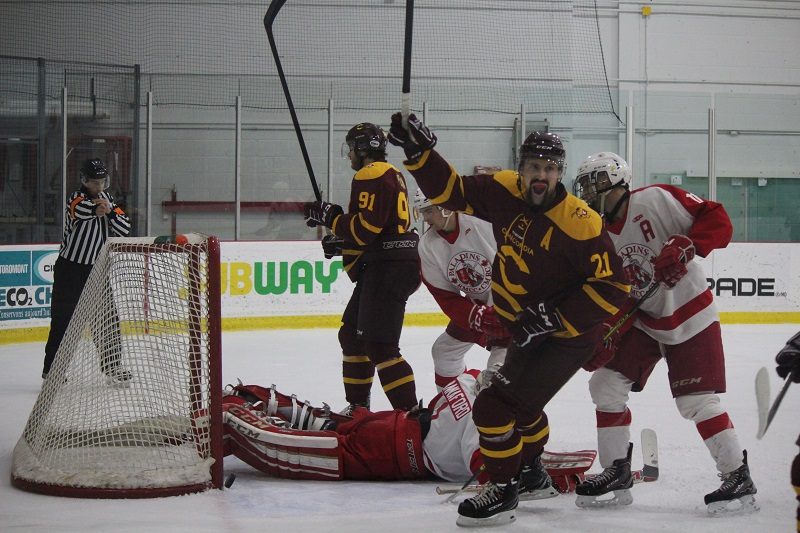Concordia hockey players talk about the moustaches they grew this month for Movember
Every November, men around the world grow moustaches to raise awareness for men’s health. Last year, over 300,000 people worldwide raised $80 million—including $15.5 million in Canada—for men’s health programs ranging from suicide prevention to early detection of prostate and testicular cancer, according to the Movember Foundation.
This year, a few players on the Concordia Stingers men’s hockey team grew moustaches in support of the cause, commonly referred to as Movember. The Concordian spoke with forwards Raphaël Lafontaine and Dominic Beauchemin, defencemen Carl Neill and Alexandre Gosselin, and assistant coach Jim Corsi about their moustaches.
Carl Neill
Neill is a rookie with the team this season. He said even though the team didn’t raise any money for Movember this year, he still grew his moustache to support the cause.
“Usually, in the past, my teams raised money with a thing called MoBro [a part of the Movember Foundation],” Neill said. “It’s fun to contribute any way you can. It’s not the same platform as famous celebrities, but if you could do it locally and people catch on, then it might spread awareness.”
Neill has the second-most points on the team this season, with four goals and 12 assists in 14 games. Both he and his defence partner, Gosselin, grew moustaches, making them look like a 70s police duo when they patrol the blue line. However, Neill said his ‘stache doesn’t compare to Gosselin’s. “I’ve had mine for a month, so I think he wins in that department,” Neill said.
All-time favourite moustache: Former Toronto Maple Leafs’ forward Lanny McDonald or Ron Burgundy, played by Will Ferrell in Anchorman.
Alexandre Gosselin
Gosselin also grew a partial goatee under his chin, so his moustache doesn’t stand out the way Neill’s does. However, when asked about a moustache-growing competition with his defence partner, Gosselin did not hold back.
“I’m sure I’m winning on that part. He’s a good hockey player, but I have a better moustache,” he said.
Like his other teammates, Gosselin said he was not raising money on his own time, but rather “doing it for the fun.”
All-time favourite moustache: Gosselin said he doesn’t know who his favourite all-time moustache is, but added that Raphaël Lafontaine has the best one on the team.
Dominic Beauchemin
Standing at six-foot-two and weighing 215 pounds, Beauchemin is an intimidating forward who has been growing a beard since training camp in August. He shaved the beard and kept the moustache for Movember, starting off the month with a handlebar moustache. However, he later traded that in for a standard ‘stache.
“I just got tired of [the handlebars], so I shaved it,” Beauchemin said, adding that it made him look like an ex-convict.
Beauchemin said it would be a great idea for the men’s hockey team to collectively raise money next November. Like Gosselin, he was honest in his assessment of who has the best moustache on the team.
“I would say, after me, I don’t know, Lafontaine has a good one too if he shaved [the rest of his beard],” Beauchemin said.
All-time favourite moustache: Concordia Stingers assistant coach Jim Corsi.
Raphaël Lafontaine
Lafontaine normally has a full beard, which suits his playing style. He plays a rugged, blue-collar game by constantly winning key face-offs, blocking shots and working hard in the defensive zone. He shaved his beard for Movember, but by the end of the month, the rest of his facial hair caught up to his moustache, so it doesn’t stand out as much as those of his teammates.
In an interview with CJLO Sports on Nov. 20, Lafontaine was humbled when the host told him that both Beauchemin and Gosselin said he had the best moustache on the team.
“Mine is not that bad,” Lafontaine said, adding that his pick on the team would be Beauchemin’s. Lafontaine said that, while he didn’t have time to raise money this year, he would like to do so next year.
All-time favourite moustache: One of the referees during the Stingers’ game against Laurentian University on Nov. 11. “I don’t know who he is, but his [moustache] was so special,” Lafontaine said. “It had a twist in it. It was very nice.”
Jim Corsi
The assistant coach didn’t grow his moustache just for Movember—he has it all the time. Corsi even has a moustache in his professional hockey pictures from the 80s.
Corsi was the goalie coach of the Buffalo Sabres in the National Hockey League (NHL) from 1999 to 2014. During that time, he invented a statistic to measure how many shots are directed at the goalie during a game. In an interview with The Concordian on Nov. 16, Corsi said his moustache helped name the modern Corsi statistic, which measures how many shots a player takes.
When former Sabres general manager Darcy Regier started talking about Corsi’s statistic on the radio, “some guy in Edmonton, [Vic Ferrari], heard about it and said, ‘Wow that’s phenomenal. I wonder if I could apply it to players,’” Corsi explained. “The Corsi number that has gone out there as a stat is an evolution of what my numbers were.”
According to Corsi, when it came time to name the stat, Ferrari, who devised the modern Corsi number, “flipped through the Buffalo Sabres media guide, saw my picture and said, ‘I love that moustache. Corsi stat—it has a great ring.’”
Main photo by Alex Hutchins.
